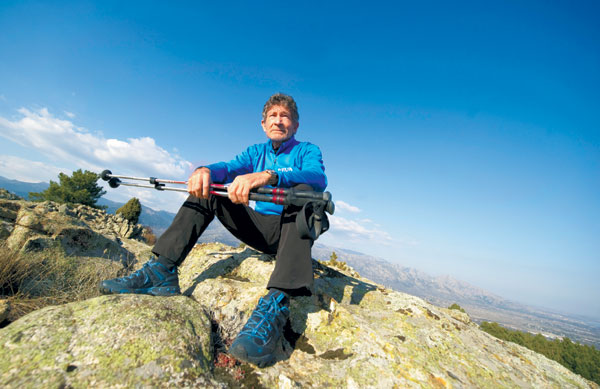Septuagenarian mountaineer to conquer 12th peak
Updated: 2012-03-03 10:38
(Agencies)
|
||||||||
MORALZARZAL, Spain - Carlos Soria grew up wandering the Sierra de Guadarrama mountains that loom north of Madrid. Still climbing now at 73, he is making his mark on the vast freezing slopes of the Himalayas.
On March 5, the grey-haired Spaniard sets off for Nepal, aiming to add a twelfth 8,000-meter peak to his list of conquests - a feat he says is already unequaled for a climber of his age.
|
 |
|
Spanish alpinist Carlos Soria, 73, is pictured in the outskirts of Moralzarzal, northwest of Madrid on Tuesday. Soria is training in the mountains near Madrid before leaving for Nepal on March 5 to try to climb Mount Annapurna. [Photo/Agencies] |
"These are the mountains of my childhood, my youth, my whole life, the ones I have seen the most of," he said, gazing at the peaks that loom over his home village of Moralzarzal, his eyes sparkling, his face lined and faintly wrinkled.
Now his aim is Annapurna, a formidable peak of 8,091 meters in the Himalayas known for its high risk of avalanches.
"It's a bit dangerous, but I'll just have to see... Above 7,000 meters, if something happens to you, no one can help," he said.
"I have permission to climb Dhaulagiri if I am doing well and feel like it," he said, naming another even higher Nepalese peak near the first, standing 8,167 meters.
That would leave only one peak of more than 8,000 meters in the world left to conquer for the muscular pensioner, who stands 1.65 meters high and weighs 59 kilos.
"The last one left is Kanchenjunga," he says - the 14th peak on his list, also in the Himalayas. "That would be for next spring."
Soria said he has climbed more of the world's highest peaks than anyone of his age.
"Nine 8,000-meter peaks after turning 60 and more after turning 65," he said. "There are people who have climbed some mountains, but not like me."
Soria left school at 11 and worked as a frame maker and then an upholsterer in Madrid, just south of where he lives now. But he constantly heard the call of the mountains.
"Whenever there was snow I would leave at noon with a little sandwich and a yoghurt to go cross-country skiing," he recalled.
"It was the post-war period. There was very little money and no information" published about the mountain routes, he says, recalling his younger days during the dictatorship of Francisco Franco.
So Soria discovered by himself the rocks and trails of the Guadarrama range, where he met his wife Cristina and trained, sometimes along with their four daughters.
It served as a practice ground for the world-class summits he went on to scale from the 1960s on - in the Alps, the Caucasus, Alaska and then the Himalayas.
There he passed the 8,000-meter mark for the first time when he was 62, climbing Qomolangma, also known as Mount Everest in the West, and then three years later, K2.
Last year, while climbing Lhotse on the Nepal-China border, he trudged on after seven younger mountaineers had to be rescued by helicopter from the freezing mountain.
"They had to have fingers amputated. Others climbed down, exhausted," he said.
But not Soria.
"I used a bit of oxygen from about 7,800 meters up to the summit. A little, very little. At the top I got rid of it and went back down without it."
He started out climbing alone and paying his own way, but his accomplishments have now earned him the sponsorship of a major bank, BBVA, which covers the $133,000 average cost of each expedition.
Soria trains for three or four hours most days, doing exercises and stretches, cycling, power-walking and rock-climbing with ropes. His diet: garlic cloves, porridge and cured meat.
"I know I am 73 years old and maybe one day I will be less strong. Not right now. Right now I am very well. I am very well mentally prepared for those mountains," he says.

 Relief reaches isolated village
Relief reaches isolated village
 Rainfall poses new threats to quake-hit region
Rainfall poses new threats to quake-hit region
 Funerals begin for Boston bombing victims
Funerals begin for Boston bombing victims
 Quake takeaway from China's Air Force
Quake takeaway from China's Air Force
 Obama celebrates young inventors at science fair
Obama celebrates young inventors at science fair
 Earth Day marked around the world
Earth Day marked around the world
 Volunteer team helping students find sense of normalcy
Volunteer team helping students find sense of normalcy
 Ethnic groups quick to join rescue efforts
Ethnic groups quick to join rescue efforts
Most Viewed
Editor's Picks

|

|

|

|

|

|
Today's Top News
Health new priority for quake zone
Xi meets US top military officer
Japan's boats driven out of Diaoyu
China mulls online shopping legislation
Bird flu death toll rises to 22
Putin appoints new ambassador to China
Japanese ships blocked from Diaoyu Islands
Inspired by Guan, more Chinese pick up golf
US Weekly

|

|






